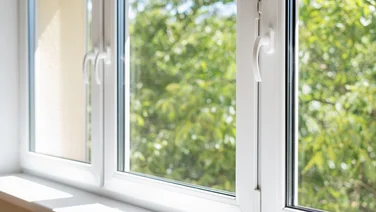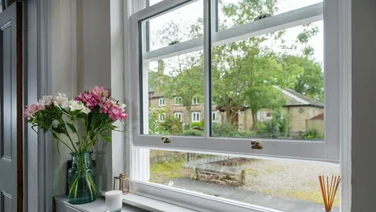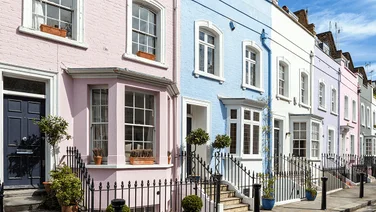- Condensation on the windows is a sign of poor ventilation
- Try to keep your home at a consistent temperature
- Prevention is the best way to maintain your windows
Double-glazed windows help keep your property insulated, helping to keep the heat in, lower your energy bills and reduce outside noise.
One of its few downsides, though, is condensation, which can occur when there’s a fault with your double-glazed windows.
This guide will tell you everything you need to know about dealing with and preventing condensation in your double-glazed windows.
If you don’t have double-glazed windows currently installed or are looking to replace your current ones, we can help. Fill in our simple quote tool and our trusted suppliers will be in touch with free, no obligation quotes.

What causes condensation in double-glazed windows?
Double glazing costs can mount up if you don’t deal with condensation, which can be caused by a number of factors.
It all depends on the type of condensation, so let’s run through the most common kinds.
Condensation on the inside of your window
If you have condensation on the inside of your windows, it means there’s too much humidity in the room, and little to no air circulation.
You’ll commonly see this in kitchens and bathrooms, where humidity levels are naturally higher than in other parts of your home.
Condensation on the inside of a window is also common if you’ve just had work done to your home. Wet plaster, drying cement, and paint give off moisture that can easily lead to condensation.
This type of condensation can also cause mould on windows, so it’s important to tackle it.
If you want to know how much new windows might set you back, look at our double glazing cost calculator.
Condensation on the outside of your window
It’s rarer, but outside condensation can happen. Thankfully though, it’s not the bad sort of condensation — in fact, it shows your double glazing is working properly.
It means your home’s insulation is thermally efficient, with little-to no-heat leaking out. Cold air from the outside reacts with the warm surface temperature of the windows, creating condensation.
Condensation in the gap between the double glazing
Condensation between the panes of your double-glazed windows usually means the sealant around the two panes is deteriorating.
Over time, the sealant used for double-glazed windows starts to degrade and crack, which lets air into the gap between the panes. This air then reacts with the moisture in the air to create condensation.
The type of sealant used can accelerate condensation. In cheaper double glazing, you’ll often see rubber strips used as a sealant, which deteriorates quicker than the more expensive silicone variety.
Another reason for condensation between the panes is a faulty spacer bar, which is used to separate the window panes creating an insulating cavity.
The spacer bar in double glazing is filled with a desiccant, which is a highly absorbent material that picks up moisture between the panes. If the spacer bar either degrades or absorbs more moisture than it can hold, excess moisture will start to form as condensation.

How to remove condensation in double-glazed windows
Which process you use to remove condensation from your window depends on where the condensation is — inside, outside, or in the window panes.
Here are the best ways to get rid of each type of condensation.
Removing inside condensation
A dehumidifier is an excellent way to remove condensation on the inside of your double-glazed windows. You can pick one up for £60–£150 and they’re a great tool for dealing with all types of excessive moisture.
A downside to dehumidifiers is their running cost, which is around 50p per day.
You can remove condensation on the inside of double glazing in your bathroom with an extractor fan. If you don’t have a fan, just open the window.
Removing outside condensation
Although outside condensation shows your double glazing is working properly, it can still be irritating to not see outside clearly.
Create more air flow by opening your windows to remove the condensation and stop it from building up again.
Removing condensation between window panes
Condensation between the panes of your double-glazed window means the seal has failed. You can either repair the window, or replace it entirely.
Repairing it is the cheaper option in the short term, but you should consider the expected life cycle of the window, and think about whether it’s worth replacing instead.
If you’re getting condensation in double glazing that’s less than 10 years old, you should check if the window’s still under guarantee. A decade is the standard warranty most double glazing companies provide.
How to prevent condensation in double glazing
The best way to deal with condensation is to prevent it happening in the first place. How you do that differs depending on whether it’s on the inside or outside of your windows, or between the two window panes.
Here’s how you can prevent each type of condensation.
Preventing inside condensation
Improving air circulation inside the affected room will help reduce humidity and help prevent condensation forming on your windows.
Try keeping your home at a consistent temperature too — frequent changes in temperature increase the chances of condensation forming.
When showering or having a bath, keep the extractor fan running throughout, or open a window. Do the same when cooking, and think about covering any pots or pans to reduce excess water vapour from circulating.
You should also avoid drying clothes inside, as this can increase moisture levels. If you have a tumble dryer, make sure the ventilation pipe points outside the window, and that there are no leaks.
Preventing outside condensation
The best way to prevent condensation forming outside your double glazing is to increase the amount of shade in the area. Shade helps to retain warmth, which limits or stops condensation from appearing.
Use tall trees, bushes, or other plants to create shade, or a dedicated structure such as an overhang.
Preventing condensation between window panes
Stopping condensation forming in between window panes is very difficult, because spotting when a gap is starting to appear in the sealant is almost impossible.
Your best option is to periodically reseal windows, which will cost you between £20–£70 per window.
Summary
- Getting condensation on double-glazed windows can be frustrating, but the benefits of double glazing far outweigh any inconvenience
- Better insulation, lower energy bills, reduced noise levels, and an increased property value are just a few reasons to get double glazing
- Improving air circulation inside the affected room will help reduce humidity and help prevent condensation forming on your windows
- Stopping condensation forming in between window panes is very difficult, because spotting when a gap is starting to appear in the sealant is almost impossible
- If you’re ready to get double-glazed windows, why not fill in this short form? Once you’ve entered a few details, our trusted suppliers will contact you with quotes to compare.







